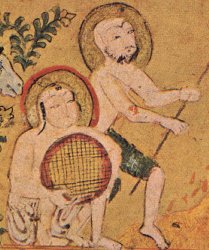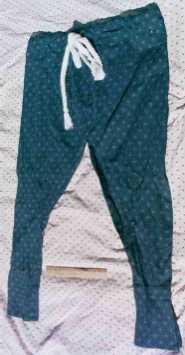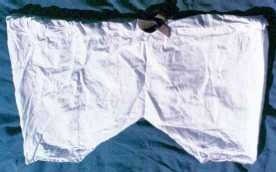|
Last Page Update:
October 1, 2001
Contact
Copyright Information
Main Page
Structure of the Red Kaganate
Gatherings, Events,...
Historic Steppes Tribes
Legends of the Nomads
Flags and other Identifiers
Clothing and Apearance
Food and related Matters
Armour
Archery
Weapons and Combat
Public Forum
Resource Links
Email:
[email protected]
Editor:
Norman J. Finkelshteyn
|
Turko-Mongol Trousers
By Steven Baker

A pair of Mamluk Trousers
|
|
Editor's Note: For another discussion of the same garment from a slightly different direction, compare the article "Salwar - Turco-Persian Pants" by Charles Mellor.
|
There are two types of trousers that are likely to have been worn. The first is the normal trouser and the second is the under trouser.
Trousers commonly worn in this period were baggy and reached to the ankle if not a little beyond. The degree of bagginess varied between cultures, places and wealth. From the most representative manuscript of Steppe nomads, the Varqa wa Gulshah, it would seem that the trousers were not excessively baggy. A nice loose fit would I suppose be the best way to describe them.
The most common colours and patterns are whites, solid colours or stripes (such as shown in figure 1). There are some pictures which show highly patterned fabrics but these could be just artistic licence. Equally they may not be as several fabric pieces have ornate designs though none of them are associated with clothing.
The last thing is the a draw string to hold the trousers at the waist. This was a cord or possibly in some cases a sash. I have found no references to what the cord was made of but one found on a 14th Century Nubian bishop was suppossedly rather like modern pyjama cord.
 |
 |
| Pictures of workers from the Book of Antidotes of
pseudo-Galen. Probably Northern Iraq 1199 |
Under trousers are to a certain extent a mystery and possibly a misnomer. We have pictures such as those from the pseudo-Galen manuscript (figures 2 and 3) plus others which show a knee length white trouser. Equally we have from the same picture men wearing nothing around their nether regions. In fact a 13th Century document states that workers working on the upper storeys of a building must wear some form of breech clout or trousers. Also, none of these pictures can be said to be of steppe nomads so it is hard to say if they wore them or not. If under trousers do exist as a separate category then they would seem to be loose fitting, knee length and made of a white material.

Reconstruction of Mamluk Trousers by S. Baker
|
An alternative possibilty is that under trousers as a category do not exist. What the nomads might have done is during the hot summer is wear just a single pair of trousers. On cold nights or during winter they may have worn many pairs of trousers. If this was the case then they would probably put the oldest or worst pair on first and put the better quality trousers on last so that only their best was showing. This would mean that a single pair of trousers could be both under and outer trousers depending on the circumstances.

Under trouser reconstruction by S. Baker, based on illustrations in period manuscripts |
Click for Trouser Pattern
The under trouser pattern shown is designed to produce two pairs of trousers. Its based on 150cm(60 inch) wide fabric. Each trouser leg is 50cms (20 inches) wide. To determine the leg width I measured the circumference of my thigh at its widest point and then rounded up to the nearest measurement that would fit nicely into this width of fabric and give me a good seam allowance (one of the benefits of loose fit clothing - you can fudge).The length of each leg is from your waist to just below your knee plus 20cm (8 inches). This additional length is folded over to form a waist band through which you thread a sash.
The crotch length was determined by placing a tape measure at the back of my waist bringing it up between my legs and measuring to the front of my waist. I then allowed a little comfort room and read the measurement. I halved this and used this length as the length for the centre portion of the crotch pieces. The long side of the crotch pieces I determined by measuring down from my waist to just above the knees. To both of these measurements I added the 20cm (8 inches) for the waist band.
To assemble it you take two of the front crotch pieces and sew the short sides together so that they match the same pattern as the rear crotch piece. You should leave a small opening about 15cm from the top as this will be where you thread your sash through. You then fold each leg in half and join them together with the crotch pieces.
Trousers can be made using the same pattern by extending the leg length to be from your waist to your ankles plus the extra 20cm.
This is a somewhat reorganised version of the information on the Turco-Mongol trousers presented at Steven Baker's Steppes Nomad Resource Site - http://www.geocities.com/qilich.
|




